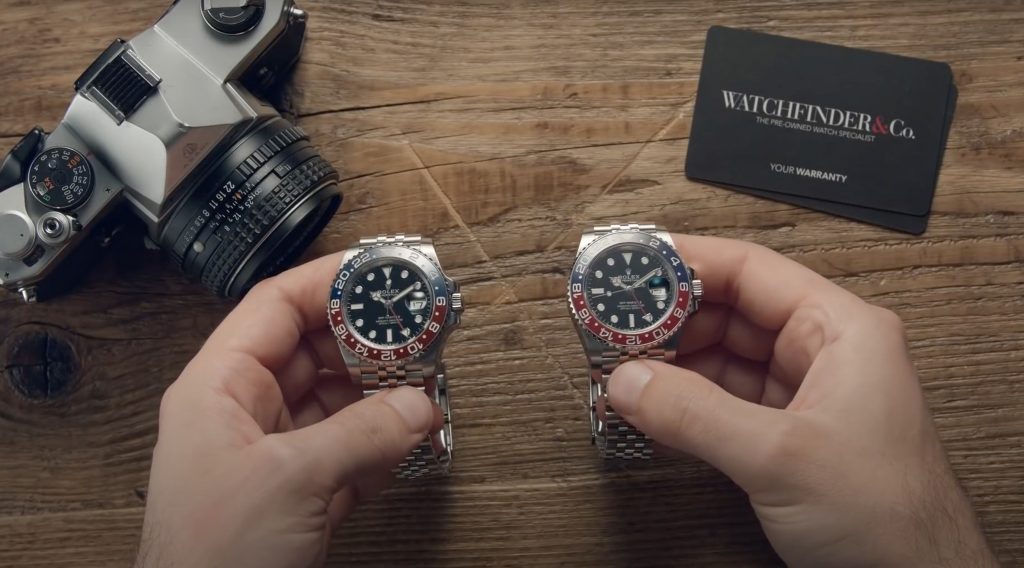Rolex fakes have existed for a very long time. But where it used to be pretty easy to spot an impostor – from the dull lustre of the cheap materials, to laughable aesthetic inaccuracies, to the sound of the rotor rattling from across the boardroom table like a bag of Skittles – it is now increasingly difficult. It’s something Watchfinder has demonstrated in this extraordinary comparison video.
As I’m sure almost all of you will know, the meteoric rise in the popularity of steel Professional models like the Submariner, GMT-Master II and Daytona has meant that enthusiasts are paying as much as four times more than retail to get their hands on one. Such is the demand for these products.
This means that now, more than ever, these illegitimate watches are really, really big business. And because only the uppermost echelon of AD cohorts can buy the real deal, fake Rolex watches with Swiss automatic movement are now also a mighty economy in their own right. As time goes on, the money invested into making them much higher quality is justified by the exorbitant prices, running now to the thousands, not hundreds of dollars people are prepared to pay for fakes.

So, with this in mind, Watchfinder talks through how this has happened and three reasons why the cheeky buggers making best 1:1 Rolex replica watches are getting much, much better at it. So, pay attention, and challenge yourself to spot the differences. Because it sure ain’t as easy as it used to be. And that’s coming from someone who actually owns a Pepsi, granted one longer in the tooth than this version, that incidentally is 100 per cent authentic and photographed by us.
3D printing
Although still in its infancy, what 3D printing has been able to accomplish in its relatively short existence is staggering. A full-sized house, guns and even human tissue – all these things have been 3D printed. The potential of the technology appears boundless. It comes as little surprise then that the people making these high-quality fakes have flocked to 3D printers to help them replicate — with pinpoint, faultless accuracy — these counterfeits.
As Watchfinder also points out, the technology is becoming so accessible and cost-effective that low-volume, high-quality fakes are relatively inexpensive to create. And it’s as easy as pressing CTRL+C and CTRL+V – the rest is taken care of. 3D printing has democratised the process of rapid prototyping, and the net results are fake watches that, to the naked eye at least, look indistinguishable to the genuine product.
Quality control
As Watchfinder rightly points out, Rolex cannot release a product until it is 100 per cent perfect. If they did, it could potentially destroy their brand, and seeing as Rolex is one of the most recognised and valuable brands on planet earth, faultlessness is an imperative. When models with faults do make it to market, boy do they make a stir.
The demand has never been stronger
Fake Rolex models with high quality don’t occur in a vacuum. The demand for them, as stated earlier, has never been higher. Because of this, the counterfeiters are incentivised to make a better final product, and they can charge more for it. The escalation in aftermarket prices is commensurate with the escalation in the price of fakes. As Watchfinder observes, there’s a loyal and global fan base of consumers who are giving more and more oxygen to this particularly nasty industry.
Conclusion
So what’s to be made of all this? Well, unfortunately, the salient takeaway from this excellent video, at least for myself, is that you shouldn’t buy a modern Rolex unless it’s from an authorised dealer. Need I remind you of the close to home Horology House hoax of 2020?
Of course, the trouble with saying, “Don’t buy a Rolex clone unless it’s from an AD” is that’s much easier said than done in 2020. So what’s the solution? Perhaps Watchfinder can create a video to address that great burning question next.